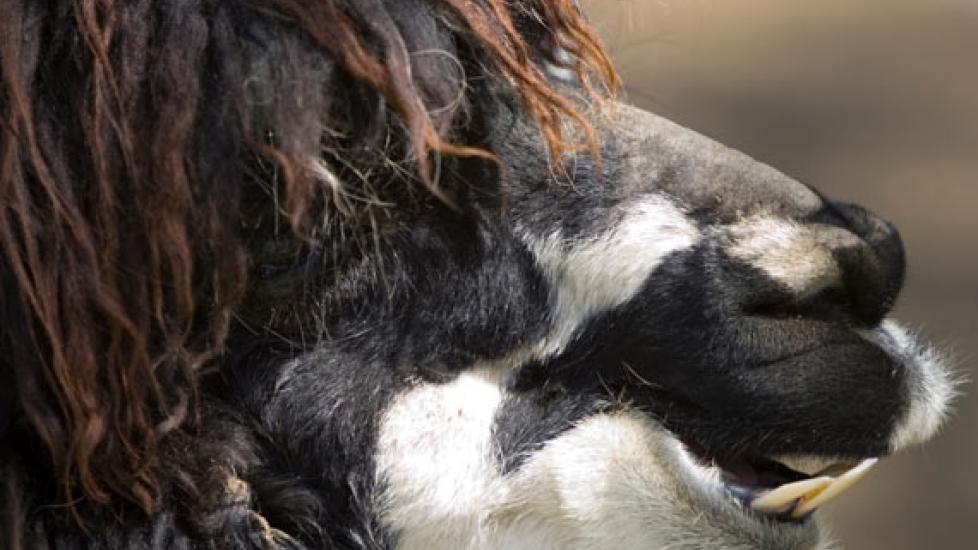Dental Care for Cows, Goats, and the Surprisingly Vicious Llama
Last week we talked about horse teeth, which receive a lot of attention in the large animal veterinary realm. There’s floating and removing wolf teeth and estimating age based on tooth wear — equine dentistry has a little bit of everything. But what about our other farm animals?
Cattle, sheep, goats, llamas, and alpacas have a major difference in their dentition as compared to horses. These ruminants and pseudoruminants do not have incisors on the top, only on the bottom. Instead, on the top they have what is called a dental pad, which is a thick, hard gum line where the animal can pinch blades of grass, nipping the forage off with the bottom incisors. All farm species still have top and bottom molars for grinding in the back of the mouth.
Calves have a set of 20 deciduous (baby) teeth, all of which come in by the age of two weeks. Then, starting at about a year of age, the permanent adult teeth start erupting. Over the bovine’s next few years, a total of 32 adult teeth will emerge with the outer incisors taking the longest to erupt between 36 and 48 months of age. This provides an estimator of age for animals under 4 years.
All told, an adult cow or bull will have six incisors along the bottom front of the jaw, one canine on each side following the outer incisor, then three premolars and three molars in each cheek quadrant.
Cattle don’t typically have the uneven wear issues with their teeth like horses do. This may be largely in part due to the fact that most cattle are housed such that they can maintain a diet of constant grazing, versus many horses that are not allowed to graze as often as they should. Instead, cattle suffer from various bacterial mouth issues, stemming mostly from the fact that around the barn and in large feeding bunks lie sharp, pointy objects that undiscerning cattle slurp up with the rest of the hay or grain. These infections have cool, archaic names like lumpy jaw and wooden tongue and calf diphtheria, and are usually treated with a round of antibiotics.
Like cattle, sheep and goats have 20 deciduous teeth and 32 adult teeth, all in the same places as their larger bovine counterparts. As ruminants and small ruminants age, their incisors begin to space apart and become worn, creating gaps between the teeth. At ages beyond five years, incisors begin to fall out occasionally and the animal has what is referred to as a “broken mouth” which I always thought was a little harsh considering a sheep or cow or goat can do just fine with a few missing front teeth. I think it gives them character.
Alpaca and llama dental care is very different from both horses and ruminants. While camelids have an upper dental pad instead of top incisors just like ruminants, their lower incisors continually grow longer throughout the animal’s life and can sometimes protrude beyond the upper lips and interfere with grazing. For this reason, many camelids need their lower incisors trimmed. A veterinarian usually does this easily with a drill. Just shaving the tops off the incisors is usually all that’s needed on a yearly basis.
Male camelids also have canine teeth. These are often referred to as “fighting teeth” and for very good reason. Males use them for fighting other males in the herd to establish dominance. These fighting teeth are razor sharp and males can inflict serious damage on each other, going for legs, ears, and, yes, testicles. The camelid world is a brutal world.
For safety reasons, we often remove the fighting teeth in males. Females can have them too, but they often barely break the gum surface and are very small — nowhere near the daggers of the males. Removal of fighting teeth is fairly simple, often involving only a wire to saw through the tooth at the gum line.
Most males don’t get their fighting teeth until they reach two to three years of age. Some late bloomers may get them at six or seven years. And the real kicker? There are two canines on each side of the upper jaw, one on each side of the lower jaw. That’s a total of six fighting teeth. Sometimes it’s like opening a shark’s mouth!
So, there you have it — farm animal dentistry in a nutshell.

Dr. Anna O'Brien
Image: Brad Wynnyk / Shutterstock
